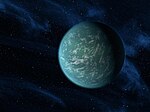글리제 433
Gliese 433| 관찰 데이터 Epoch J2000.0 Equinox J2000.0 | |
|---|---|
| 콘스텔레이션 | 히드라 |
| 적경 | 11h 35m 26.9474s[1] |
| 적위 | - 32° 32° 23.883°[1] |
| 겉보기 등급(V) | 9.81[2] |
| 특성. | |
| 스펙트럼형 | M2V[3] |
| 겉보기 등급(U) | 12.508[2] |
| 겉보기 등급(B) | 11[2].1997 |
| 겉보기 등급(R) | 8.82[2] |
| 겉보기 등급(I) | 7.664[2] |
| 겉보기 등급(J) | 6.471[2] |
| 겉보기 등급(H) | 5.856±0.036[2] |
| 겉보기 등급(K) | 5.623±0.021[2] |
| U-B 색지수 | 1.23[2] |
| B-V 색지수 | 1.489±0.004[2] |
| V-R 색지수 | 0.99[2] |
| R-I 색지수 | 1.16[2] |
| 아스트로메트리 | |
| 반지름 속도(Rv) | +17.986±0.0006km[4]/s |
| 고유운동(μ) | - RA:70.768 mas/년[1] - Dec.:850.679mas/년[1] |
| 시차()) | 110.1711 ± 0.0204 mas[5] |
| 거리 | 29.605±0.005y (9.077 ± 0.002 pc) |
| 절대 등급(MV) | 10.07[2] |
| 세부 사항 | |
| 덩어리 | 0.48[6] M☉ |
| 반지름 | 0.529±0.021[7] R☉ |
| 광도 | 0.034[8] L☉ |
| 거주 가능 구역 내부 한계 | 0.186AU[9] |
| 거주가능구역외부한계 | 0.362AU[9] |
| 표면 중력(log g) | 4.81±0[10].14kg |
| 온도 | 3,445±50[7] K |
| 금속성 [Fe/H] | - 0.02±0.05[11] 덱스 |
| 회전 | 73.2±16.0 d[12] |
| 회전 속도(v sin i) | 1.0[7] km/s |
| 기타 명칭 | |
| 데이터베이스 참조 | |
| 심바디 | 데이터. |
| 외계 행성 기록 보관소 | 데이터. |
| 외계 행성 백과사전 | 데이터. |
| 데이터 원본: | |
| 히파르코스 카탈로그, CCDM(2002년), 밝은 별 카탈로그(5차 개정판) | |
글리제 433은 적도의 히드라자리에 위치한 여러 개의 외계 행성 동반성을 가진 어두운 적색왜성이다.이 계는 시차 측정에 근거해 태양으로부터 29.6광년 거리에 있으며, 반경 속도 +18km/[4]s로 멀어지고 있다.우주에서의 움직임으로 보아 오래된 [8]원반별입니다.겉보기 등급은 9.81이고[2] 절대 등급은 10.07로 [2]육안으로 보기에는 너무 어둡다.
이 별은 M2V [3]등급의 작은 M형 주계열성이다.이[13] 별은 자전 주기가 약 73일이고[12] 질량의 [8]별들의 평균 활동 수준보다 낮은 나이든 별이다.이 별의 질량은 태양의 48%,[6] 반지름은 53%[7]입니다.유효 온도 3,445 [7]K의 광구에서 태양 광도의 3.4%[8]만 방출하고 있습니다.
행성계
글리제 433 b는 항성 글리제 433 주위를 도는 외계 행성이다.이 행성은 지구 질량의 최소 6배에 달하는 슈퍼 지구로, 약 0.056AU의 반장각으로 항성을 공전하는 데 약 7일이 걸린다.이 행성은 2009년 10월에 보도 자료를 통해 발표되었지만, 그 당시에는 어떠한 발견 논문도 [14]입수할 수 없었다.투오미 등이 2014년 발표한 논문에서 설명한 연구는 글리제 433 b와 2012년에 이전에 발견된 또 다른 후보 행성인 글리제 433 [15]c를 모두 확인했습니다.
2020년 1월에 발견된 글리제 433 d는 질량이 글리제 433 b와 매우 비슷하지만 실제로는 항성 거주 가능 범위 내에서 약간 더 먼 궤도를 돌고 있지만 여전히 항성과 너무 가깝기 때문에 보존적인 거주 가능 [9][16]영역의 좁은 경계 내에 있기에는 너무 따뜻하다.
글리제 433 c는 별에서 가장 먼 궤도를 돈다.지금까지 발견된 행성 중 가장 가깝고 넓고 차가운 해왕성 같은 행성이다.이 행성은 모항성과 다른 [16]행성에서 멀리 떨어져 있는 큰 행성치고는 특이한 궤도를 가진 것으로도 유명하다.
허셜 망원경을 이용한 조사는 항성 주변에서 적외선 초과 현상을 발견했는데, 이는 궤도를 도는 별주위 원반이 존재한다는 것을 보여준다.이 성질은 아직 해결되지 않았지만 평균 온도가 30 K일 때 [13]항성으로부터 반경 16 AU 이내에 있습니다.
| 동반자 (별부터 순서대로) | 덩어리 | 세미마조르 축 (AU) | 공전 주기 (일) | 편심 | 기울기 | 반지름 |
|---|---|---|---|---|---|---|
| b | 6.0🜨 M 이상 | 0.054 | 7.0 | 0.08 | — | — |
| d | 5.223 ± 0.921 M🜨 | 0.178 ± 0.006 | 36.059 ± 0.016 | 0.07 ± 0.05 | — | — |
| c | 28 28 . 78 + 19 . 15 - 10 . 46🜨 M | 4.692+1.120-0 .768 | 4,873.923+1,796.128 −1,034.762 | 0.21+0.08 −0.21 | — | — |
「 」를 참조해 주세요.
레퍼런스
- ^ a b c VizieR에서 이 소스에 Brown, A. G. A.; et al. (Gaia collaboration) (August 2018). "Gaia Data Release 2: Summary of the contents and survey properties". Astronomy & Astrophysics. 616. A1. arXiv:1804.09365. Bibcode:2018A&A...616A...1G. doi:10.1051/0004-6361/201833051.대한 Gaia DR2 레코드.
- ^ a b c d e f g h i j k l m n o Anderson, E.; Francis, Ch. (2012). "XHIP: An extended hipparcos compilation". Astronomy Letters. 38 (5): 331. arXiv:1108.4971. Bibcode:2012AstL...38..331A. doi:10.1134/S1063773712050015. S2CID 119257644.
- ^ a b Henry, Todd J.; et al. (2002). "The Solar Neighborhood. VI. New Southern Nearby Stars Identified by Optical Spectroscopy". The Astronomical Journal. 123 (4): 2002–2009. arXiv:astro-ph/0112496. Bibcode:2002AJ....123.2002H. doi:10.1086/339315. ISSN 0004-6256. S2CID 17735847.
- ^ a b Soubiran, C.; et al. (2018). "Gaia Data Release 2. The catalogue of radial velocity standard stars". Astronomy and Astrophysics. 616: A7. arXiv:1804.09370. Bibcode:2018A&A...616A...7S. doi:10.1051/0004-6361/201832795. S2CID 52952408.
- ^ Brown, A. G. A.; et al. (Gaia collaboration) (2021). "Gaia Early Data Release 3: Summary of the contents and survey properties". Astronomy & Astrophysics. 649: A1. arXiv:2012.01533. Bibcode:2021A&A...649A...1G. doi:10.1051/0004-6361/202039657. S2CID 227254300. (에라타: doi:10.1051/0004-6361/202039657e).VizieR에서 이 소스에 대한 Gaia EDR3 레코드.
- ^ a b Zechmeister, M.; et al. (August 6, 2009). "The M dwarf planet search programme at the ESO VLT + UVES. A search for terrestrial planets in the habitable zone of M dwarfs". Astronomy and Astrophysics. 505 (2): 859–871. arXiv:0908.0944. Bibcode:2009A&A...505..859Z. doi:10.1051/0004-6361/200912479. S2CID 16845441.
- ^ a b c d e Houdebine, E. R. (September 2010). "Observation and modelling of main-sequence star chromospheres - XIV. Rotation of dM1 stars". Monthly Notices of the Royal Astronomical Society. 407 (3): 1657–1673. Bibcode:2010MNRAS.407.1657H. doi:10.1111/j.1365-2966.2010.16827.x.
- ^ a b c d Delfosse, X.; et al. (May 2013). "The HARPS search for southern extra-solar planets. XXXIII. Super-Earths around the M-dwarf neighbors Gl 433 and Gl 667C". Astronomy & Astrophysics. 553: 15. arXiv:1202.2467. Bibcode:2013A&A...553A...8D. doi:10.1051/0004-6361/201219013. A8.
{{cite journal}}: CS1 유지보수: 포스트스크립트(링크) - ^ a b c "PHL's Exoplanets Catalog". University of Puerto Rico at Arecibo. 5 December 2019. Retrieved 26 January 2020.
- ^ Stassun, Keivan G.; et al. (2016). "Accurate Empirical Radii and Masses of Planets and Their Host Stars with Gaia Parallaxes". The Astronomical Journal. 153 (3): 136. arXiv:1609.04389. Bibcode:2017AJ....153..136S. doi:10.3847/1538-3881/aa5df3. S2CID 119219062.
- ^ Lindgren, Sara; Heiter, Ulrike (2017). "Metallicity determination of M dwarfs. Expanded parameter range in metallicity and effective temperature". Astronomy and Astrophysics. 604: A97. arXiv:1705.08785. Bibcode:2017A&A...604A..97L. doi:10.1051/0004-6361/201730715. S2CID 119216828.
- ^ a b Suárez Mascareño, A.; et al. (September 2015). "Rotation periods of late-type dwarf stars from time series high-resolution spectroscopy of chromospheric indicators". Monthly Notices of the Royal Astronomical Society. 452 (3): 2745–2756. arXiv:1506.08039. Bibcode:2015MNRAS.452.2745S. doi:10.1093/mnras/stv1441. S2CID 119181646.
- ^ a b Kennedy, G. M.; et al. (June 2018). "Kuiper belt analogues in nearby M-type planet-host systems". Monthly Notices of the Royal Astronomical Society. 476 (4): 4584–4591. arXiv:1803.02832. Bibcode:2018MNRAS.476.4584K. doi:10.1093/mnras/sty492.
- ^ "32 New Exoplanets Found". ESO News. ESO. Retrieved 15 February 2012.
- ^ Tuomi, Mikko; Jones, Hugh R. A.; Barnes, John R.; et al. (2014). "Bayesian search for low-mass planets around nearby M dwarfs – estimates for occurrence rate based on global detectability statistics". Monthly Notices of the Royal Astronomical Society. 441 (2): 1545–1569. arXiv:1403.0430. Bibcode:2014MNRAS.441.1545T. doi:10.1093/mnras/stu358. ISSN 1365-2966.
- ^ a b c Feng, Fabo; Butler, R. Paul; Shectman, Stephen A.; et al. (2020). "Search for Nearby Earth Analogs. II. Detection of Five New Planets, Eight Planet Candidates, and Confirmation of Three Planets around Nine Nearby M Dwarfs". The Astrophysical Journal Supplement Series. 246 (1): 38. arXiv:2001.02577. Bibcode:2020ApJS..246...11F. doi:10.3847/1538-4365/ab5e7c. ISSN 1538-4365. S2CID 210064560. 11.






